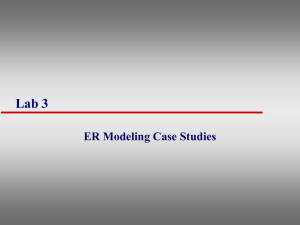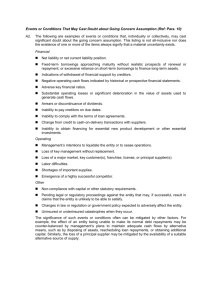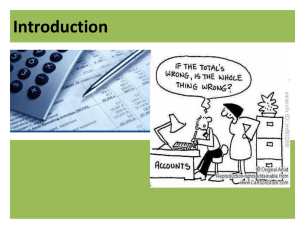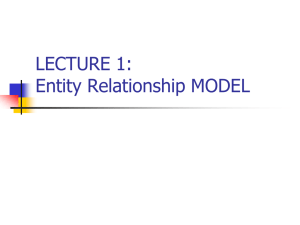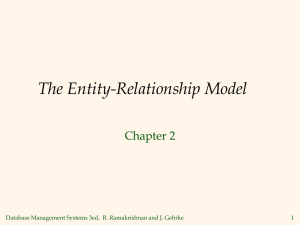Chapter 11
advertisement
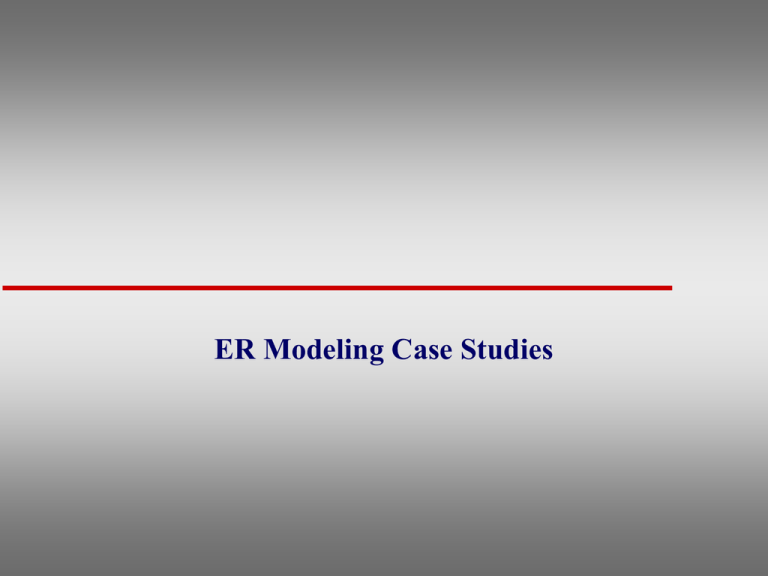
ER Modeling Case Studies
BanksDatabase :ER Case Study
Consider the following set of requirements for a Bank database that is
used to keep track of Customer.
a) Each bank has a unique name.
b) Each branch has a number, name, address (number, street, city), and set of
phones.
c) Customer includes their name, set of address (P.O. Box, city, zip code,
country), set of phones, and social security number.
d) Accounts have numbers, types (e.g. saving, checking) and balance. Other
branches might use the same designation for accounts. So to name an
account uniquely, we need to give both the branch number to which this
account belongs to and the account number.
e) Not all bank customers must own accounts and a customer may have at
most 5 accounts in the bank.
f) An account must have only one customer.
g) A customer may have many accounts in different branches.
2
Banks Database :ER Case Study
Design an ER schema for this application, and draw an
ER diagram for that schema.
Specify key attributes of each entity type and
structural constraints on each relationship type.
Note any unspecified requirements, and make
appropriate assumptions to make the specification
complete.
3
Banks Database :ER Case Study
Branch
Branch_NO{PK}
Name
Address
Number
Street
City
Phone[1..*]
Customer
SSN {PK}
Name
Address [1..*]
P.O Box
Code
City
Country
0..*
Phone [1..*]
has
Account NO
1..1
1..1
Bank
Name {PK}
1..1
Reason of chasm trap :
Note all customer should
have an account .So we
can not answer this
question :
List all customer
available on a specific
branch?
0..*
Contains
Owns
0..5
Account
Type
Balance
0..*
4
Banks Database :ER Case Study
To avoid chasm trap we
add this relationship
Branch
has
1..*
0..*
Customer
SSN {PK}
Name
Address [1..*]
P.O Box
Code
City
Country
0..*
Phone [1..*]
Branch_NO{PK}
Name
Address
Number
Street
City
Phone[1..*]
0..*
has
Account NO
1..1
1..1
Bank
Name {PK}
1..1
Contains
Owns
0..5
Account
Type
Balance
0..*
5
Organization :ER Case Study
Organization made up of various departments, each having a name,
identifying no., and an employee who is the manager. A department
may be located in different places. Information about employee
includes name, identification number, birth date, address, sex, and
salary. Each employee is assigned to one department. The date the
manager is appointed to a department is also tracked. Employees may
be directly supervised by another employee. Each project within the
organization is controlled by a department. Employees (not necessarily
from the controlling dept.) are assigned to projects. Information about
projects includes project name, no., and location. Hours spent by
employees on each project are also kept.
6
Organization :ER Case Study
draw an ER diagram to represent the data requirements as
following:
– Identify the main entity types.
– Identify the main relationship types between the entity types.
– Identify attributes and associate them with entity or relationship
types.
– Determine candidate and primary key attributes for each (strong)
entity type.
– Determine the multiplicity constraints for each relationship .State
any assumptions necessary to support your design.
7
Organization :ER Case Study
supervises
1..*
Supervisee
Employee
Department
0..1
Supervisor
1..*
NO{PK}
Name
Birthdate
Sex
Salary
1..*
assigns to
Employee
1..1
Dep_NO{PK}
Name
Location[1..*]
\Total_of_employee
1..1
Manager
Manages
Worker
0..1
1..1
Start Date
Works on
1..*
Hours
Controls
Project
Pro_NO{PK}
Name
Location
0..*
8
Hospital :ER Case Study
A General Hospital consists of a number of specialized wards (such
as Radiology, Oncology, etc) .Information about ward includes unique
name, total numbers of current patients. Each ward hosts a number of
patients, who were admitted by a consultant (doctors) employed by the
Hospital. On admission, the date and time are kept. The personal
details of every patient includes name, Medical Recode Number
(MRN), set of phone and one address (city, street, code). A separate
register is to be held to store the information of the tests undertaken.
Each test has unique episode No. , category and the final result of test.
Number of tests may be conducted for each patient. Doctors are
specialists in a specific ward and may be leading consultants for a
number of patients. Each patient is assigned to one leading consultant
but may be examined by other doctors, if required.
9
Hospital :ER Case Study
draw an ER diagram to represent the data requirements as
following:
– Identify the main entity types.
– Identify the main relationship types between the entity types.
– Identify attributes and associate them with entity or relationship
types.
– Determine candidate and primary key attributes for each (strong)
entity type.
– Determine the multiplicity constraints for each relationship .State
any assumptions necessary to support your design.
10
Hospital :ER Case Study
Ward
Doctor
Name {PK}
\Total_of_pat
1..1
Specializes in
0..*
Doc_NO{PK}
Consultant
0..*
0..*
0..*
Examiner
Admits
Date
Time
1..1
Leader
Exams
0..*
0..*
Patient
MRN{PK}
Name
Phone [1..*]
Address
Code
Street
City
consults
0..*
Test
1..1
conducts
0..*
Ep _NO{PK}
Category
Result
11
Department :ER Case Study
Identify the entities and relationships for the following description
and draw an ER diagram.
Departments, identified by ID, operate a variety of printers, each
located in a particular room in a particular building. Printers are
supplied by a number of suppliers, identified by name, with each
supplier charging a different price for a given printer, but also
providing different delivery delays, measured in days. A given room
can have any number of printers, including none.
12
Department :ER Case Study
13
Journal :ER Case Study
Identify the entities and relationships for the following description
and draw an ER diagram.
Persons, described by their name, SSN, and address, subscribe to
various journals. Each journal, identified by a title and an ISBN, has a
set of numbered volumes and each of these has a set of numbered
issues. Subscribers have an initial subscription date and a termination
date for each journal to which they subscribe.
14
Journal :ER Case Study
15
